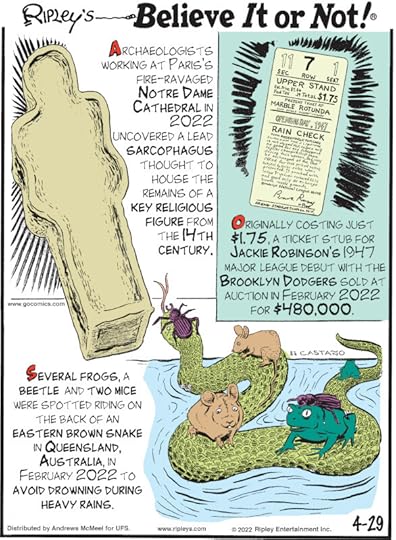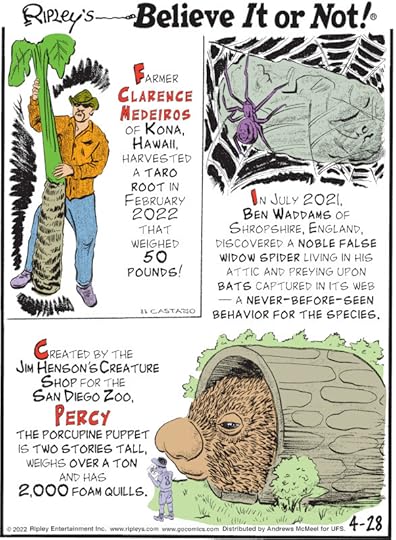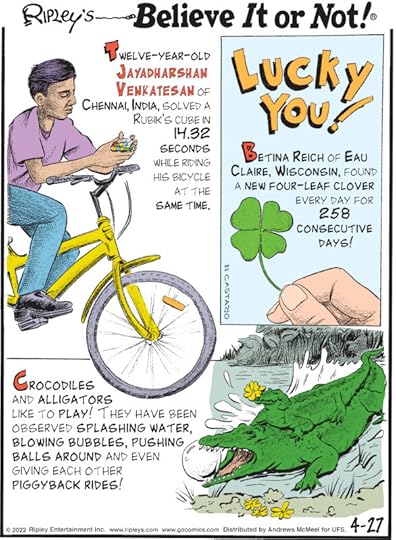Ripley Entertainment Inc.'s Blog, page 90
April 30, 2022
CARTOON 04-30-2022
April 29, 2022
Whiskey Business: Is Scotch The Future Of Fuel?
Featured in Ripley's Believe It or Not!

You may not often hear the words drinking and driving paired in a positive light, but that could change soon enough as a Scottish biofuel company makes headway in using one of the word’s favorite spirits to fuel your car!
What a Waste!Renowned for its malty, fruity, smoky flavor, Scotch whiskey is so popular that 44 bottles are shipped around the globe each second, culminating in an industry worth about $6 billion per year!
Like most things, whiskey’s manufacturing process has a dark side: for each liter produced, there are about 10 liters of a watery residue known as “spent lees,” 8 liters of pot ale, and 2.5 kilograms of a solid by-product called “draff” left behind. That’s over 2.3 billion liters of pot ale and 684,000 metric tons of draff produced every year!
Currently, a lot of the by-product goes straight into rivers, oceans, and landfills, but biofuel scientist Martin Tangney may have found a way for the world to continue drinking up without the waste!
Turning Draff into DieselIn 2007, Tangney founded the UK’s first biofuel research center at Napier University, where he first began searching for a cheap base material to turn into a sustainable, commercially viable biofuel, researching “everything from newspaper to seaweed.”
After stumbling upon whiskey by-products in 2011, he left the Uni and branched out on his own, forming Celtic Renewables, under which he developed a fermentation process known as acetone-butanol-ethanol (ABE) to break down the sugars in the draff and pot ale, turning it into acid. From there, the acids are broken down into solvents — like butanol and ethanol — which can be added to gas or diesel to put your car into motion.
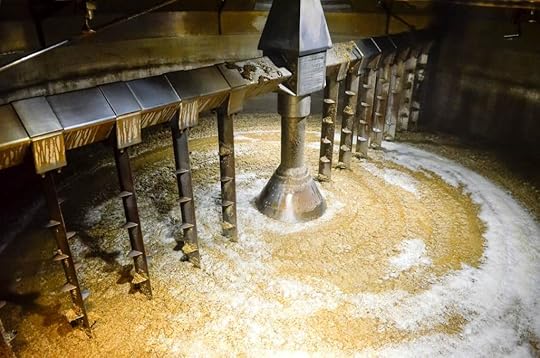
The company demonstrated the power of its process by driving an unmodified Ford fueled by 15% biobutanol.
While Tangney’s fermentation process is new on the scene, we’d be remiss not to mention that Glenfiddich Distillery also makes their own biogas out of their own by-products to knock their trucks’ carbon emissions down 90%!
That being said, the Tangney’s process isn’t limited to converting whiskey waste, and could expand to other food groups, including dairy. The solvents could also substitute oil in the production of cosmetics, pharmaceuticals, electronics, and plastics!
“That’s where we see ourselves adding value,” he said.
Biofuel or Biofools?The concept of biofuels is nothing new. Rudolf Diesel first experimented with peanut oil back in the late 1800s when searching for fuel for his namesake engine. In the 1930s, Henry Ford became a huge fan of plant-based ethanol, which he called the “fuel of the future.”
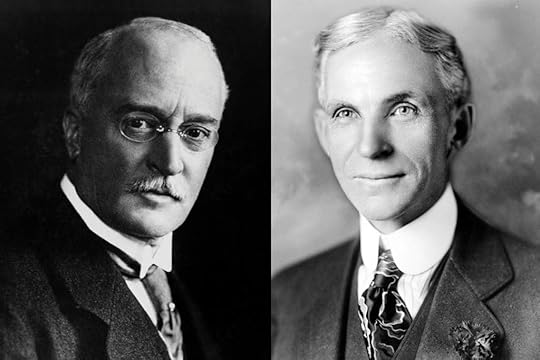
Rudolf Diesel (left) and Henry Ford (right).
While that still may be true, it’s a bit further into the future than Ford anticipated since turning crops into fuel proved costly, and oil was cheap and readily available!
Biofuels have been under scrutiny for years, as they’re often promoted as a low-carbon alternative to fossil fuels, despite the production of them being a bit counterproductive, as it requires a lot of land, which leads to concerns about biodiversity, food security, and carbon storage.
Tangney’s fermentation process is considered a huge step up from these controversial biofuels, specifically because it’s made from “genuine waste,” rather than just participating in a cycle of wastefulness.
An independent analysis of Tangney’s product is in the works, with a full evaluation of its environmental benefits to come later this year.
By Meghan Yani, contributor for Ripleys.com
EXPLORE THE ODD IN PERSON! Discover hundreds of strange and unusual artifacts and get hands-on with unbelievable interactives when you visit a Ripley’s Odditorium!An Anthology Of Ripley’s Fashion
Featured in Ripley's Believe It or Not!

When it comes to strange and historical fashion statements, Ripley’s Believe It or Not! has collected the best of the bizarre over the years, and in honor of this year’s Met Gala, we are rolling out our favorites!
Toilet Paper DressesWe’re kicking off with the intricate toilet paper dress that won the 2016 Cheap Chic Toilet Paper Wedding Dress Contest. Titled “Winter Lust,” this winning design was created by Van Tran of Brooklyn, New York, earning her the first place prize of $10,000!
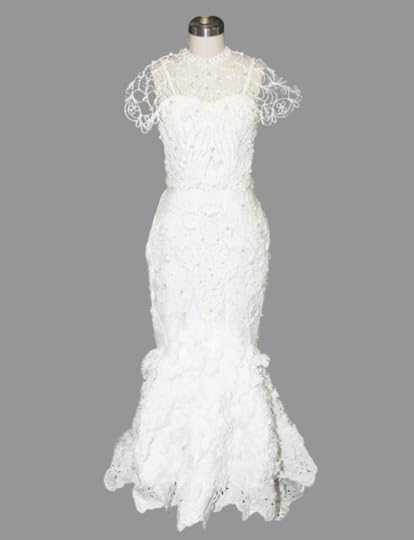
Back when the contest first aired on The Martha Stewart Show, Edward Meyer (Ripley’s exhibit buyer at the time) knew we had to get involved, and in the eleven years since, Ripley’s has proudly been a sponsor of this great contest.
Here are some of the rules designers had to follow:
Must use Charmin brand toilet paperThey were allowed to use any type of tape and/or any type of glueThey could also use needle and threadThe dress must be able to be worn by a human and be able to be taken on and offThe Spiderweb DressThis dress was created by Robert Bernard de Leon of Orlando, and is composed entirely of spiderwebs found near the artist’s home. Featured in the bodice is a genuine six-inch Mexican tarantula spider!

Ripley’s owns several paintings on cobwebs, but this is our first three-dimensional cobweb sculpture! Unfortunately this dress can’t actually be worn; it has been glued on the mannequin in order to prevent damage to the webs and maintain its shape.
“Sole” Mates: Chinese Children’s Lion SlippersIt is customary in Chinese culture for every child to be assigned an animal at birth that the family believes represents their personality. A cap and slippers are then designed in the form of the chosen animal, like the lion-faced slippers shown here, and presented to the infant.
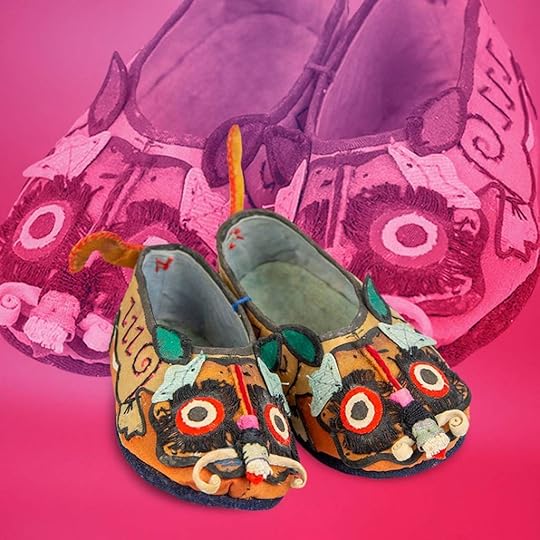
When called upon to execute a person guilty of murder, shamans from Australia’s Aboriginal peoples were said to wear shoes made of emu bird feathers and human hair, all matted together with human blood. Sometimes known as kurdaitcha shoes, these were worn by the ritual executioner, or “kurdaitcha man.”

The shoes are called “interlinia” in Northern Australia and “intathurta” in the South. The oval-shaped footwear have an opening in the center and are secured upon the foot with a band of human hair. It was believed that these shoes would leave no tracks and assuring a clean getaway. When not in use, the shoes would be kept wrapped in kangaroo skin or hidden in a sacred place.
Back To The Future Part II ShoesDesigned by Nike designer Tinker Hatfield, these sneakers were worn by Michael J. Fox when he time-traveled to Hill Valley in the year 2015 in the 1989 movie Back to the Future Part II. Although the shoes appeared to lace themselves in the film, the effect was actually achieved by people pulling the laces through holes on the ground off-screen!
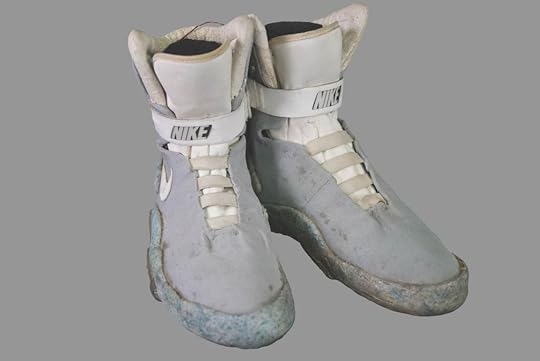
But fast-forward to a few years after the movie took place, and the internet was all abuzz when self-lacing shoes became a reality.
The Apple company filed a patent back in 2019 for a motorized adjustment system so that the shoe would lace itself just like in the film, but Apple wasn’t the only company on the verge of bringing these shoes to life. Nike had been working on a self-lacing shoe for years and released the extremely limited Air Mag shoes in a raffle, where all the proceeds went to the Michael J. Fox Foundation for Parkinson’s Research.
Cork Clutch BagAn ingenious example of fashionable recycling, this clutch purse is made entirely out of wine bottle corks!
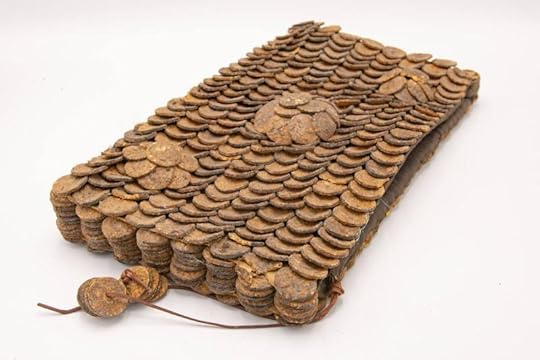
Cork has been known to make life boats, life preservers and even ping pong balls, but is most often used as a stopper in bottles of wine. Now we can add fashionable accessories to that list!
Bat Teeth NecklaceNo fashion statement can be complete without the proper accessories, namely this antique bat tooth necklace. This woven necklace is lined with two rows of teeth from the flying fox bat, the largest species of bat in the world, and one row of small polished shells. The people of New Guinea would hang nets between trees to trap the flying foxes. Once captured, the bats were eaten and their teeth saved for the jewelry.

This list is just the beginning! You can check out tons more of these fashion oddities at one of our Ripley’s Odditoriums!
EXPLORE THE ODD IN PERSON! Discover hundreds of strange and unusual artifacts and get hands-on with unbelievable interactives when you visit a Ripley’s Odditorium!Source: An Anthology Of Ripley’s Fashion
CARTOON 04-29-2022
April 28, 2022
CARTOON 04-28-2022
April 27, 2022
When Newspaper Monsters Terrified Children
Featured in Ripley's Believe It or Not!

When a child picks up a newspaper, it is often to see the wacky adventures of Snoopy or if Garfield still hates Mondays. Flashback to 1902, children who expected the funny pages instead found the scary drawings of Walt McDougall.
Monstrous AccomplishmentsIn the history of American newspapers, McDougall was one of the most accomplished cartoonists. He began his career as an engraver for The New York Daily Graphic while freelancing for other outlets like Harper’s Weekly and Puck.
McDougall got his big break at the New York World, where he collaborated with Mark Fenderson on the first American color comic strip “The Unfortunate Fate of a Well-Intentioned Dog.” He was also the first syndicated cartoonist through his work on Bill Nye’s (unrelated to the Science Guy) editorial column for the American Press Association.
The Monster in Politicians’ ClosetsDuring his time at New York World, McDougall drew many political cartoons. One of his cartoons, “The Royal Feast of Belshazzar Blaine and the Money Kings,” was instrumental in influencing the 1884 presidential election. In this cartoon, McDougall created a parody of Belshazzar’s feast from the bible, comparing it to Republican nominee James. G Blaine’s feast with wealthy benefactors before the election.
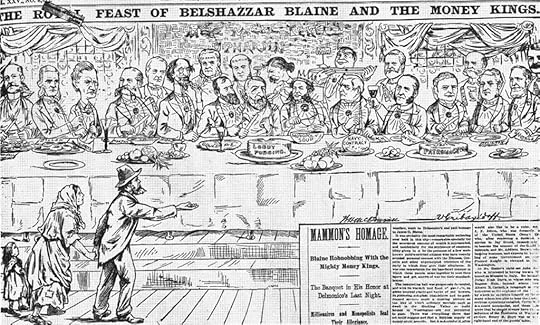
New York World, October 30, 1884.
Spread across New York billboards, the cartoon scared Blaine out of key votes to win the state, which resulted in his loss to Democratic nominee Grover Cleveland.
Drawing NightmaresBesides his work in politics, McDougall’s body of work expanded to “Walt McDougall’s Good Stories for Children,” published in the Herald. In addition to a misleading name, the series consisted of children interacting with monsters in perilous situations.
The stories included text with a lesson or dialog from the strange creatures, which gave some context to the disturbing images oozing off the inked pages. McDougall created this series to show children that despite the wonders of the world, there is always danger afoot.
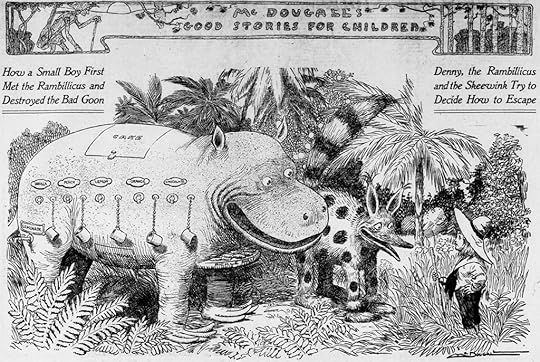
The Salt Lake Herald, 24 Aug. 1902. Chronicling America: Historic American Newspapers. Lib. of Congress.
Follow the Yellow Brick RoadWhile many were frightened by McDougall’s work, others were engrossed with his work. L. Frank Baum, the author of The Wonderful Wizard of Oz, clicked his heels three times to collaborate with McDougall on a comic strip.
Together the two created Queer Visitors from the Land of Oz, which saw various Oz characters adventuring around the United States. The purpose of the comic strip was to promote The Marvelous Land of Oz, a sequel to his smash hit.

The North American (Philadelphia), Nov. 20, 1904.
The Fascination of Childhood HorrorWhether it be the monster in their closet or the desire to see a scary movie, children are fascinated with horror in some shape or form. Nowadays, children may not rush to read a newspaper filled with monsters, but books like Goosebumps and video games like Five Nights at Freddy’s show McDougall was onto something in his horror compositions. He managed to tap into a timeless and infinite resource: fear of the unknown.
By James Whelan, contributor for Ripleys.com
EXPLORE THE ODD IN PERSON! Discover hundreds of strange and unusual artifacts and get hands-on with unbelievable interactives when you visit a Ripley’s Odditorium!CARTOON 04-27-2022
April 26, 2022
Released Documents Reveal Plan To Nuke The Moon
Featured in Ripley's Believe It or Not!

Truth is stranger than fiction, especially when it comes to the very recent history of one of the Department of Defense’s most secretive programs: the Advanced Aerospace Threat Identification Program (AATIP). The AATIP operated from 2007 to 2012, gobbling millions of taxpayer dollars with little oversight (via Live Science).
Lack of accountability coupled with an endless cash flow inspired officials at the AATIP to dabble in some genuinely bizarre technologies. We’re talking the kind of stuff you expect to see in an episode of Star Trek or a Harry Potter film: traversable wormholes, antigravity devices, and even invisible cloaks. But the scheme that takes the cake remains a proposal to tunnel through the moon using nuclear explosives.
Yep, you read that right. Here’s the story of one of the most hair-brained and scary military plots you’ve never heard of.
The AATIP Meets FOIAThe New York Times first announced the existence of the Advanced Aerospace Threat Identification Program (AATIP) in 2017. According to Popular Mechanics, the Defense Intelligence Agency (DIA) funded the AATIP. In turn, the AATIP studied phenomena related to UFOs. Of course, this revelation sparked the intense scrutiny of individuals fascinated by the alien question.
But searching the night skies for flying saucers was far from the only thing that the AATIP participated in. We know this because of a four-year-old Freedom of Information Act (FOIA) request by Vice for dozens of documents that recently got filled. The FOIA request resulted in a cache of 51 documents, numbering just under 1,600 pages. The documents enclosed in these pages include contracts, proposals, reports, and meeting notes.
While these might sound like run-of-the-mill documents, the papers have revealed some surprising and mysterious AATIP activities. You can get an eyeful for yourself by clicking this link. These documents detail everything from stargates and negative energy to wormholes that can be navigated. There are also discussions of warp drive, communications utilizing high-frequency gravitational waves, and something referred to as “extra-dimensional manipulation.”
The Reading Gets CrazierReading these reports and papers can leave you feeling as if you’re inside a sci-fi realm. But it’s worth noting that the authors of the recently released documents also spend a fair amount of time discouraging the use of these technologies. They label some impractical, while others get stamped as flat-out impossible. But these remain just the tip of the iceberg regarding the outlandish ideas these researchers bounced around.
Perhaps the wildest remains a proposal about negative mass propulsion that details the possibility of nuking the moon for interstellar mining. The authors wished to do this in the search for highly lightweight metals. According to the report, the metal in question is as hard as steel yet 100,000 times lighter. But there was a kink in their plan: the location of the metal is at the center of the moon.
So, they considered blasting a tunnel into the moon and relying on thermonuclear explosions. Fortunately, the crazy plan never came to fruition, but it still has people who’ve dived into the papers scratching their heads.
The Vice dump of AATIP documents follows fast on the heels of another recent document release that went to The Sun, a British tabloid. The Sun’s dump included more than 1,500 pages dealing with various aspects of extraterrestrial visitation. Namely, it explored the physiological impacts on humans of “alien abduction.” These symptoms include paralysis and “unaccounted for pregnancies” — Believe It or Not!
By Engrid Barnett, contributor for Ripleys.com
EXPLORE THE ODD IN PERSON! Discover hundreds of strange and unusual artifacts and get hands-on with unbelievable interactives when you visit a Ripley’s Odditorium!CARTOON 04-26-2022
April 25, 2022
CARTOON 04-25-2022
Ripley Entertainment Inc.'s Blog
- Ripley Entertainment Inc.'s profile
- 52 followers



